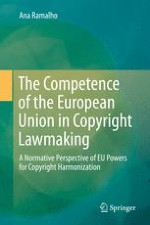2016 | OriginalPaper | Buchkapitel
3. Colonizing the Normative Gap: The Intervention of the Court of Justice
verfasst von : Ana Ramalho
Erschienen in: The Competence of the European Union in Copyright Lawmaking
Aktivieren Sie unsere intelligente Suche, um passende Fachinhalte oder Patente zu finden.
Wählen Sie Textabschnitte aus um mit Künstlicher Intelligenz passenden Patente zu finden. powered by
Markieren Sie Textabschnitte, um KI-gestützt weitere passende Inhalte zu finden. powered by
